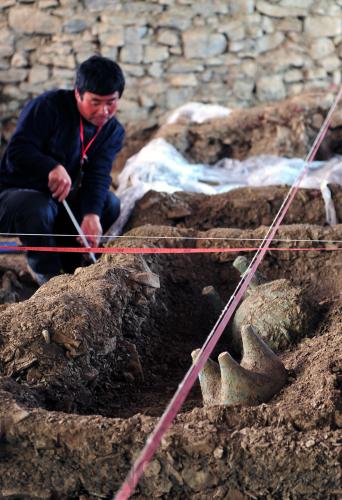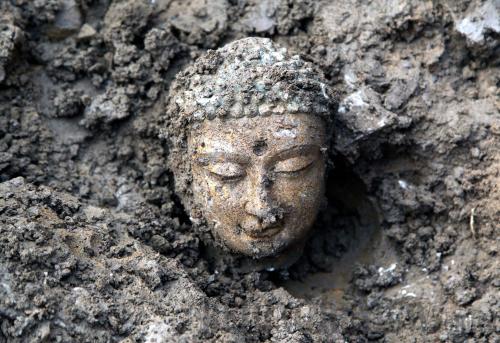|
 |
|
BURIAL GROUND: Scientists work on the Jiwanggu Tomb site in Shandong Province on April 16, 2012 (ZHU ZHENG) |
The Jiwanggu Tomb of the late Spring and Autumn Period is located 40 km northwest of Yishui County. The tomb was accidentally uncovered by construction workers in early 2012. Later, archeologists excavated many bronze artifacts, including eight horse statues, four carriages and sacrificial wares. The scale and shape of the tomb suggests that Jiwanggu was meant for the upper class of the time.
Liu Xu, a Peking University archeologist, said the tomb reveals a unique structure. The coffin chamber as well as the horse and carriage pit were situated inside the same grotto. The east side of the pit consists of rows of pillars, which is rare among tombs of the period.
 |
|
DIGGING DEEP: Archeologists unearthed a great number of Buddha statues at the Yecheng site in Hebei Province in March 2012 (CFP) |
A royal Buddhist temple from the Eastern Wei and Northern Qi dynasties was found at Yecheng in March 2012.
In a pit nearby, archeologists have unearthed 2,895 stone Buddha statues, mainly made of white marble. It is the largest hoard ever discovered in China. Yecheng served as the ancient capital of six successive dynasties across several centuries.
Archeologist Li Yuqun, said findings from Yecheng provide valuable evidence in the study of Buddhism in China.
The Hailongtun fortress, located in Zunyi, was constructed by the Bozhou Tusi government in 257 during the Southern Song Dynasty (1127-1279) and destroyed during the war against Ming Dynasty rule in 1600.
The term Tusi refers to local minority chieftains during Song, Yuan and Ming dynasties. For hundreds of years, imperial officials governed remote areas and borderlands via such hereditary leaders.
The well preserved site is surrounded by a 6-km-long wall and consists of a combination of fortresses, an administrative office as well as palace of varying ages.
Bai Yunxiang, an archeologist, said Hailongtun fortress provides important clues as to the local Tusi system, which was eventually abolished during the Qing Dynasty (1644-1911).
Email us at: baishi@bjreview.com | 